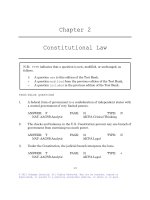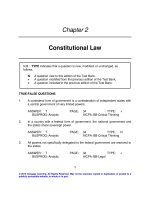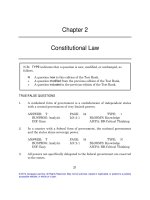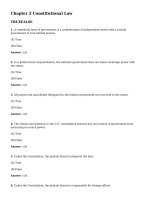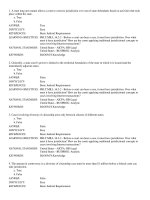Bus law today 9th ed ch04
Bạn đang xem bản rút gọn của tài liệu. Xem và tải ngay bản đầy đủ của tài liệu tại đây (181.36 KB, 29 trang )
BUSINESS LAW TODAY
Essentials 9th Ed.
Roger LeRoy Miller - Institute for University Studies, Arlington, Texas
Gaylord A. Jentz - University of Texas at Austin, Emeritus
Chapter
4
Torts and Cyber Torts
© 2011 Cengage Learning. All Rights Reserved. May not be copied, scanned, or duplicated, in whole or in part, except for use as permitted in
a license distributed with a certain product or service or otherwise on a password-protected website for classroom use.
1
Learning Objectives
What is a tort?
What is the purpose of tort law? What
are the two basic categories of torts?
What are the four elements of
negligence?
What is meant by strict liability? In what
circumstances is strict liability applied?
What is a cyber tort, and how are tort
theories being applied in cyberspace?
© 2011 Cengage Learning. All Rights Reserved. May not be copied, scanned, or duplicated, in whole or in part, except for use as permitted in
a license distributed with a certain product or service or otherwise on a password-protected website for classroom use.
2
The Basis of Tort Law
A tort is a private, civil legal action to
obtain monetary damages from a legal
injury a person or property.
Damages:
Compensatory Damages: actual losses. Puts plaintiff in
position he would have been in if the tort had not
occurred. Special Damages: quantifiable such as lost
wages, medical bills. General Damages: nonmonetary
losses such as pain and suffering.
Punitive Damages: punish wrongdoer, typically only
available in intentional torts.
© 2011 Cengage Learning. All Rights Reserved. May not be copied, scanned, or duplicated, in whole or in part, except for use as permitted in
a license distributed with a certain product or service or otherwise on a password-protected website for classroom use.
3
The Basis of Tort Law
Plaintiff (injured party) sues the
Defendant (tortfeasor).
Classification of Torts:
Intentional.
Unintentional (negligence-no fault).
Strict Liability (absolute liability).
© 2011 Cengage Learning. All Rights Reserved. May not be copied, scanned, or duplicated, in whole or in part, except for use as permitted in
a license distributed with a certain product or service or otherwise on a password-protected website for classroom use.
4
Intentional Torts: Assault and
Battery
Assault: the reasonable apprehension or
fear of immediate contact.
Battery: completion (contact) of the
assault.
No motive is necessary, and plaintiff can
be compensated for emotional harm.
Defenses:
Consent.
Self-Defense and Others.
Defense of Property.
© 2011 Cengage Learning. All Rights Reserved. May not be copied, scanned, or duplicated, in whole or in part, except for use as permitted in
a license distributed with a certain product or service or otherwise on a password-protected website for classroom use.
5
Intentional Torts Against
Persons
False Imprisonment.
Confinement or restraint of another person’s
activities without justification.
Merchants can detain a suspected shoplifter as
long as there is probable cause.
Infliction of Emotional Distress.
Extreme and outrageous conduct.
Some courts require physical symptoms.
© 2011 Cengage Learning. All Rights Reserved. May not be copied, scanned, or duplicated, in whole or in part, except for use as permitted in
a license distributed with a certain product or service or otherwise on a password-protected website for classroom use.
6
Defamation
Defamation: Publication of a false
statement (oral or written) that injures a
person’s good reputation.
Fact or Opinion?? Opinions are free
speech and generally not actionable.
Slander is oral, Libel is written. Statements
made on the internet may be libel.
Publication Requirement: third party must
hear or see statement. An individual who
re-publishes the statement may be liable.
© 2011 Cengage Learning. All Rights Reserved. May not be copied, scanned, or duplicated, in whole or in part, except for use as permitted in
a license distributed with a certain product or service or otherwise on a password-protected website for classroom use.
7
Defamation - Damages
Libel: damages are presumed as a
matter of law. Plaintiff need not prove
she was actually injured. Reason: libel
is “permanent” and continues to harm
after statement made.
Slander : plaintiff must prove special
damages (statement actually caused
monetary loss). Reason: slander is
temporary.
Exception: Slander per se
© 2011 Cengage Learning. All Rights Reserved. May not be copied, scanned, or duplicated, in whole or in part, except for use as permitted in
a license distributed with a certain product or service or otherwise on a password-protected website for classroom use.
8
Defamation
Defamation.
Slander per se (no proof of damages is
required):
• Loathsome communicable disease.
• Professional impropriety.
• Imprisonment for a serious crime.
• Unmarried woman is unchaste.
© 2011 Cengage Learning. All Rights Reserved. May not be copied, scanned, or duplicated, in whole or in part, except for use as permitted in
a license distributed with a certain product or service or otherwise on a password-protected website for classroom use.
9
Defamation
Defamation Defenses.
Truth is normally an absolute defense.
Statement was Privileged:
• Absolute: judicial and legislative proceedings.
• Qualified: good faith, limited.
Public Figures: plaintiff must show
statement made with “actual malice.”
© 2011 Cengage Learning. All Rights Reserved. May not be copied, scanned, or duplicated, in whole or in part, except for use as permitted in
a license distributed with a certain product or service or otherwise on a password-protected website for classroom use.
10
Invasion of Privacy
Invasion of the Right to Privacy.
Person has the right to solitude. Breach of that
duty is a tort.
Appropriation of identity (discussed ).
Intrusion into private affairs or seclusion.
False Light.
Public disclosure of private facts.
What about the rights of internet users?
© 2011 Cengage Learning. All Rights Reserved. May not be copied, scanned, or duplicated, in whole or in part, except for use as permitted in
a license distributed with a certain product or service or otherwise on a password-protected website for classroom use.
11
Appropriation
Use of another person’s name, likeness
or other identifying characteristic,
without permission, with benefit to user.
Degree of Likeness is distinguished by
different courts.
Right of Publicity as a property right:
focuses on commercial exploitation of
likeness
© 2011 Cengage Learning. All Rights Reserved. May not be copied, scanned, or duplicated, in whole or in part, except for use as permitted in
a license distributed with a certain product or service or otherwise on a password-protected website for classroom use.
12
Fraudulent Misrepresentation
Fraudulent (Intentional)
Misrepresentation.
Intentional deception of another that causes
belief in a condition that is different from the
condition that already exists.
•
•
•
•
Knowing misrepresentation of fact.
Intent to induce innocent party to rely.
Justifiable reliance by innocent party.
Causation and Damages.
Contrast: “puffery” or statements of opinion.
© 2011 Cengage Learning. All Rights Reserved. May not be copied, scanned, or duplicated, in whole or in part, except for use as permitted in
a license distributed with a certain product or service or otherwise on a password-protected website for classroom use.
13
Negligent Misrepresentation
Key difference between intentional and negligent
misrepresentation is whether person making the
false statement actually knew it was false.
Typically occurs when person owes a duty to
another to give correct information.
CASE 4.1 McClain v. Octagon Plaza, LLC
(2008). Defendants negligently represented size of
leased property and plaintiff justifiably relied,
resulting in $90,000 in damages.
© 2011 Cengage Learning. All Rights Reserved. May not be copied, scanned, or duplicated, in whole or in part, except for use as permitted in
a license distributed with a certain product or service or otherwise on a password-protected website for classroom use.
14
Abusive or Frivolous Litigation
Plaintiff files suit based on malice or
without a legitimate legal reason and
loses the suit, he can be sued for
malicious prosecution, recover costs of
suit and, in some states, lost profits.
Abuse of process: does not require proof
of malice or prior litigation.
© 2011 Cengage Learning. All Rights Reserved. May not be copied, scanned, or duplicated, in whole or in part, except for use as permitted in
a license distributed with a certain product or service or otherwise on a password-protected website for classroom use.
15
Wrongful Interference
Wrongful Interference with
Contracts.
Valid, enforceable contract exists
between two parties.
Third party knows about contract.
Third party intentionally causes either
party to breach the original contract.
© 2011 Cengage Learning. All Rights Reserved. May not be copied, scanned, or duplicated, in whole or in part, except for use as permitted in
a license distributed with a certain product or service or otherwise on a password-protected website for classroom use.
16
Wrongful Interference
Wrongful Interference with Business
Relationship.
Distinguish competition vs. predatory behavior.
Predatory behavior is unlawfully driving competitors
out of market.
To prevail, Plaintiff must show Defendant targeted
only Plaintiff’s customers and product.
Defenses to Wrongful Interference:
Interference was justified or permissible ( bona
fide competitive behavior).
© 2011 Cengage Learning. All Rights Reserved. May not be copied, scanned, or duplicated, in whole or in part, except for use as permitted in
a license distributed with a certain product or service or otherwise on a password-protected website for classroom use.
17
Intentional Torts Against
Property
Trespass to Land.
Occurs when a person, without permission,
enters onto (above or below) some one else’s
land; or remains on the land or permits anything
to remain on the land.
Actual damages or harm to the property is not
required to prove trespass.
© 2011 Cengage Learning. All Rights Reserved. May not be copied, scanned, or duplicated, in whole or in part, except for use as permitted in
a license distributed with a certain product or service or otherwise on a password-protected website for classroom use.
18
Intentional Torts Against
Property
Trespass to Personal Property.
Wrongfully taking or harm or interference with
exclusive right of use of personal property
(chattel) of another.
© 2011 Cengage Learning. All Rights Reserved. May not be copied, scanned, or duplicated, in whole or in part, except for use as permitted in
a license distributed with a certain product or service or otherwise on a password-protected website for classroom use.
19
Conversion
Wrongfully taking or retaining possession of
chattel and placing in service of another.
Good intentions are not a defense.
Usually occurs with trespass to personal
property.
CASE 4.2 Trustees of University of District of
Columbia v. Vossoughi (2009). Replacement
cost is appropriate measure of damages for
conversion of personal property. FMV may be
inadequate in some cases.
© 2011 Cengage Learning. All Rights Reserved. May not be copied, scanned, or duplicated, in whole or in part, except for use as permitted in
a license distributed with a certain product or service or otherwise on a password-protected website for classroom use.
20
Disparagement of Property
Occurs when economically injurious
falsehoods are made about another’s
property or product.
Slander of Quality (Trade Libel): false
statement about another’s product that
caused a third party to refrain from dealing
with plaintiff, causing financial loss.
Slander of Title: false statement about legal
ownership of another’s product resulting in
financial loss.
© 2011 Cengage Learning. All Rights Reserved. May not be copied, scanned, or duplicated, in whole or in part, except for use as permitted in
a license distributed with a certain product or service or otherwise on a password-protected website for classroom use.
21
Unintentional Torts
(Negligence)
Occurs when plaintiff is legally injured due
to defendant’s failure to live up to a
required duty of care causing foreseeable
risk of injury.
Analysis:
Did the Defendant owe the Plaintiff a legal duty of
care?
Did the Defendant breach that duty?
Did the Plaintiff suffer a legal injury?
Did the Defendant’s breach of duty cause the
Plaintiff’s injury?
© 2011 Cengage Learning. All Rights Reserved. May not be copied, scanned, or duplicated, in whole or in part, except for use as permitted in
a license distributed with a certain product or service or otherwise on a password-protected website for classroom use.
22
Negligence: Duty of Care and
Breach
Duty is based on reasonable person
standard.
How would a reasonable person have acted
under the circumstances?
Duty to Warn Business Invitees of risks, and
keep common areas safe. Exception: Obvious
risks.
Duty of Professionals to clients (attorneys,
CPA’s, doctors).
© 2011 Cengage Learning. All Rights Reserved. May not be copied, scanned, or duplicated, in whole or in part, except for use as permitted in
a license distributed with a certain product or service or otherwise on a password-protected website for classroom use.
23
Negligence: Injury Requirement
and Damages
Plaintiff must suffer a legally
recognizable injury.
Plaintiff must show she suffered loss or harm
to legally protected interest.
Not all injuries can be compensated.
Compensatory damages are norm. Punitive
damages are generally awarded only in
intentional torts.
© 2011 Cengage Learning. All Rights Reserved. May not be copied, scanned, or duplicated, in whole or in part, except for use as permitted in
a license distributed with a certain product or service or otherwise on a password-protected website for classroom use.
24
Negligence: Causation
To hold defendant liable, plaintiff must
the tortious act was both the actual and
proximate cause of the injury.
Causation in Fact: “but for” defendant’s act,
injury would not have occurred.
Proximate Cause: defendant’s act created a
foreseeable risk of injury to plaintiff (sufficient
strong connection).
© 2011 Cengage Learning. All Rights Reserved. May not be copied, scanned, or duplicated, in whole or in part, except for use as permitted in
a license distributed with a certain product or service or otherwise on a password-protected website for classroom use.
25



